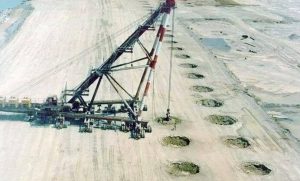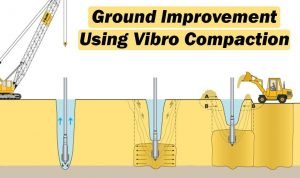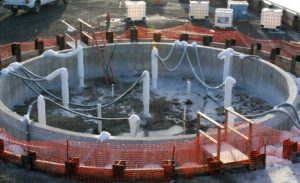7 Ground Improvement Techniques and their Applications
By adopting certain ground improvement techniques, the ground can be improved, and by using powerful depth vibrators, Vibro-compaction increases the density of the soil. For improving soft soils by using a vacuum pump, vacuum consolidation is used.
There are many ground improvement techniques such as removing pore water over time, preloading method is used and to form a crystalline or glass product by electric current, heating is used. To increase combined strength and make them impervious ground freezing converts pore water to ice.

There are many ground improvement techniques as discussed below;
- Vibro-Compaction Ground Improvement Method
- Preloading of Soil
- Vacuum Consolidation Method
- Heating or Vitrification Technique for Ground Improvement
- Ground Freezing Technique
- Soil Nailing Technique
- Micropiles for Ground Improvement
These all are the modern ground improvement techniques used these days.
Vibro-Compaction Ground Improvement Method:
Vibro-compaction is the rearrangement of soil particles into a denser configuration by the use of powerful depth vibration and is one of the most common ground improvement techniques.

This process is to create stable foundation soils for densifying loose sands and to compact soils and fills, vibration can be used. There is a simple principle behind Vibro-compaction and with specially designed vibrating probes Vibro Compaction is performed. In the past, both horizontal and vertical modes of vibration have been used.
Applications of Vibro-compaction Method:
There are the following applications of this method such as;
- Due to seismic activity, reduction of risk of liquefaction.
- The foundation settlements reduction.
- It allows construction on granular fills.
Preloading of Soil:
To improve soil properties, preloading has been used for many years without a change in the method and to remove pore water over time, it is the process of placing additional vertical stress on a compressible soil. The volume causing settlement can reduce by pore water dissipation.

The design considerations which should be made are slope stability, bearing capacity, degree of consolidation and the soils treated are varved silts, organic silt, and clays, soft clay. For ground improvement, Surcharging is an economical method and the consolidation of the soils is time-dependent.
Applications of Preloading of Soil:
There are the following applications of preloading of soil such as;
- It reduces secondary compression, post-construction, and settlement.
- Densification and improve bearing capacity.
Vacuum Consolidation Method:
For the improvement of saturated soft soils, vacuum consolidation is an effective means and the soil site is covered with an airtight membrane, and by using dual venture and vacuum pump, the vacuum is created underneath it.

About 4.5 m high conventional surcharge fill, this technology can provide an equivalent pre-loading and by reducing the pore pressure while maintaining constant total stress, vacuum-assisted consolidation preloads the soil.
Applications of Vacuum Consolidation Method:
There are the following applications of this method such as;
- Eliminating the risk of failure due to replace standard preloading techniques.
- To build large developments on thick compressible soil, this method is used and in the scare fill area, it is combined with a water preloading.
- Using the increased stability combine with embankment pre-load.
Heating or Vitrification Technique for Ground Improvement:
It is one of the ground improvement techniques in which to form a crystalline or glass product, heating or vitrification breaks the soil particle down and to heat the soil and modify the physical characteristics of the soil it uses electrical current. The properties of the soil permanently alter by heating the soils.
The temperatures can range between 300 and 1000 degrees Celsius depending on the soil and when heating is used, the impact on adjacent structures and utilities should be considered.
Application of Heating or Vitrification Technique:
There are the following applications of this method such as;
- Immobilization of contaminated soil or radioactive soil.
- Stabilization and densification.
Ground Freezing Technique:
To convert in-situ pore water to ice, ground freezing is the use of refrigeration and then the ice acts as a cement or glue and bonding together adjacent particles of blocks of rock or soil to increase their combined strength.

These ground improvement techniques include Refrigeration system geometry, Thermal analysis, Thermal properties of soil and rock, freezing rates, Energy requirements, etc.
Applications of Ground Freezing Technique:
There are the following applications of ground freezing technique such as;
- These ground improvement techniques are temporary support for excavation and temporary underpinning.
- The prevention of groundwater flows into excavated areas.
- Temporary containment of toxic or hazardous waste contamination and temporary slope stabilization.
Soil Nailing Technique:
The concept of this method consists of reinforcing the ground by passive inclusions, closely spaced which restrain displacements and create in-situ soil.

The basic design consists of transferring the resisting tensile forces into the ground through the friction mobilized at the interfaces and these forces are generated in the inclusions.
Applications of Soil Nailing Technique:
There are the following applications of soil nailing technique such as;
- Stabilization of highway cut slopes and railroads.
- For high-rise buildings and underground facilities, excavation retaining structures in urban areas.
- In steep and unstable stratified slopes, it is used for tunnel portals.
Micropiles for Ground Improvement:
Micropiles are up to 300 mm diameter piles with the capability of sustaining high loads over 5000 KN and to be drilled through virtually every ground conditions, the drilling equipment and methods are used. At any angle below horizontal with minimal vibration, disturbances, and noise these Micropiles are drilled.

To operate in locations with low headroom and severely restricted access the equipment can be further adapted.
Applications:
There are the following applications of these ground improvement techniques such as;
- For Structural stability and support.
- For new structures foundations.
- Replacement or repair of the existing foundation.
- Prevention of movement and Soil protection and strengthening.
